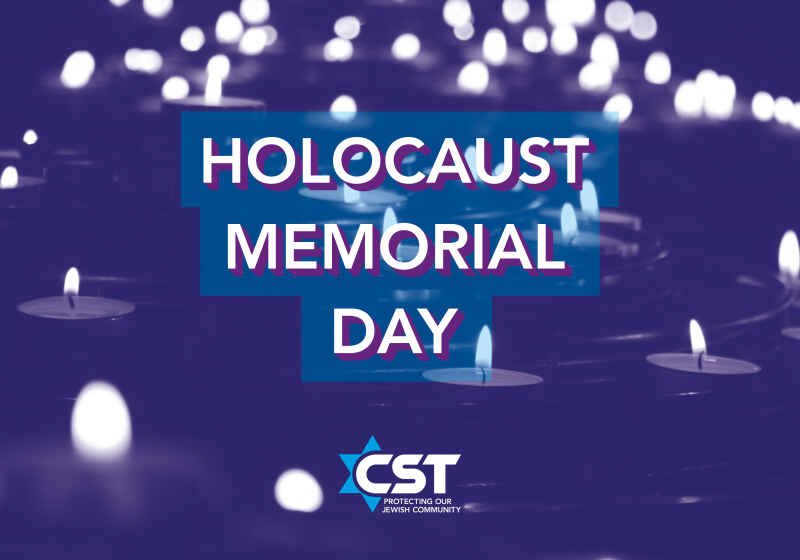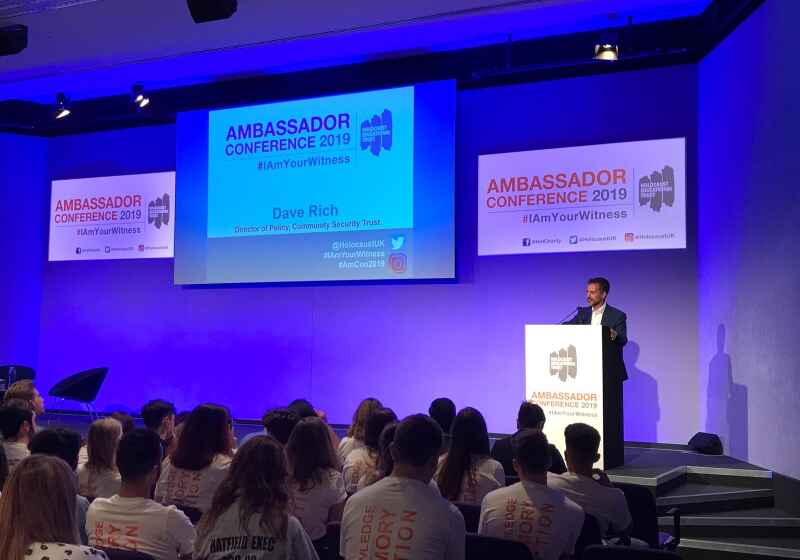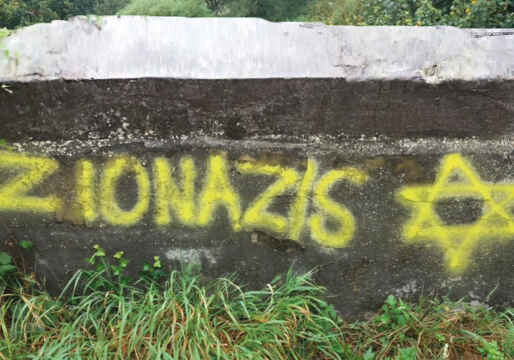CST Blog
How to trivialise the Holocaust
24 January 2011
any man's death diminishes me, because I am involved in mankind
John Donne's words remind us that every war, massacre, famine, natural disaster or genocide touches all of us, as human beings, whoever we are and whatever the identity of those involved. The idea of comparing different episodes of human suffering to compete for attention and political reward is a particularly distasteful one. This is especially the case when, in order to attract attention to one episode, you belittle others. This sort of exercise should not be allowed to pass without comment, despite the unease felt at having to make comparisons between one example of human suffering and another.
Holocaust trivialisation is one of the many ways in which the scale, nature and meaning of the Nazi attempt to exterminate European Jewry are diminished and their memory obliterated. A lesser cousin of outright Holocaust Denial, it is a way of undermining the memory of the Holocaust by bracketing it with very different tragedies or conflicts, in the process stretching the meaning of genocide until it means nothing at all.
This abuse of Holocaust memory is become an increasingly common theme of anti-Zionist politics in recent years. It represents a misguided and immoral attempt to undermine Israel's legitimacy by sidestepping the catastrophe that befell Europe's Jews during the last century. One way in which this has manifested itself is in repeated assaults, both from Islamists and the far left, on mainstream Holocaust remembrance commemoration.
The Islamic Human Rights Commission, never slow to adopt the most egregious anti-Israel campaigns, now holds a 'Genocide Memorial Day'. It is no coincidence that this takes place shortly before the national Holocaust Memorial Day, to which it is intended to be a counterpoint. According to the IHRC, their day is meant to remember:
...all mans inhumanity to man in the perpetration of genocides and genocidal acts.
Two years on from the genocidal acts in Gaza, this event combines the past with the present so that this day is a call not just to commemorate the past but also the present genocidal tendencies together with building a resolve to stop genocides from ever happening again.
This event consists of a variety of short presentations on the world's many victims. This year we will be covering a number of atrocities including the heart rending plight of the peoples of Hiroshima and Nagasaki, the suffering of the genocide in Cambodia and accounts from the victims of the Jewish Holocaust.
To accompany their event, the IHRC have produced a 'Genocide Memorial Day Calendar', each month providing an opportunity to remember a different example of man's inhumanity to man. Their choice of which acts of genocide to include in the calendar gives plenty of food for thought.
The calendar has an introductory page, which explains:
Genocide Memorial Day is an annual event that was inaugurated in January 2010. It is a day given to remember mans inhumanity to man in the perpetration of genocides and genocidal acts. Its foundation is based on the argument by various thinkers that several genocides underpin the modern era. Such genocides include the genocide of slavery, the near eradication of Native Americans, the extermination of populations in the Congo, and India, the Nazi Holocaust as well as more recent genocides and genocidal acts including against Palestinians, Bosnians, Indiegnous [sic] peoples in Australia and Central America, Chechens, Darfurians and in Rwanda to name but a few.
Then comes the monthly list, with the IHRC's description of each genocide in italics:
January - Gaza: During the Israeli assault on Gaza during the 22 Day war (2008 - 09), 1,434 Palestinians were killed of which 288 were children and 181 were women. A further 5,303 Palestinians were injured in the assault, including 1,606 children and 828 women.
February - Sarajevo: The siege of Sarajevo in Bosnia-Herzegovina by Serb forces lasted from April 1992 until February 1996. According to the UN, it is estimated that nearly 10,000 people were killed or went missing in the city, including over 1,500 children. An additional 56,000 people were wounded, including nearly 15,000 children.
March - Rwanda: In 1994, almost 1 million people, mainly Tutsis, were killed by Hutu attackers in Rwanda.
April - Auschwitz: Estimates of numbers of Roma and Sinti people killed by the Nazis in the second world war range from 200,000 to 500,000.
May - Australia: The Stolen Generation refers to those Aboriginal and Torres Straits Islanders Children who were affected by the forced removal policy of the Australian government. This was an official policy that operated between 1909 and 1969 and aimed to assimmilate aboriginal peoples into wider society, eventually eradicating all indigenous peoples as a result. An estimated 100,000 people were affected by this policy.
June - Ireland: The Irish Famine (An Gorta Mor) of 1845 - 1850 is thought to have taken between one and four million lives, with a further one to two million people emigrating from Ireland as a result. The famine was brought about by a set of catastrophic social policies instigated under British rule, as well as an abysmal failure at famine relief by the British authorities.
July - Srebrenica: In July 1995, Dutch UN peacekeepers in the so-called UN safe have of Srebrenica in Bosnia, allowed in Serb forces, who subsequently killed some 8,000 Bosnians.
August - Chechnya: In 1944 upon a trumped up charge of collaboration the entire Chechen nation of 400,000 along with some 100,000 Ingush were deported en masse on the orders of Josef Stalin from their homeland in the Caucasus. It is thought that one third of the population was exterminated as a result.
September - Chile: It is estimated that between 2,000 and 3,500 people were killed or disappeared under the dictatorship of General Augusto Pinochet; up to 100,000 tortured and some 200,000 forced into exile. Two thirds of those killed or disappeared date from 1973, when on September 11, Pinochet led a US backed coup against the elected government of Salvador Allende.
October - Treblinka: The Treblinka concentration camp was set up by the Nazis in Occupied Poland. Between July 1942 and October 1943, 800,000 people were killed there, the majority of whom were Jewish, and a substantial number of whom were Roma.
November - Palestine: The Nakba (The Catastrophe) refers to the events of 1948 when Israel was created. That year saw the mass deportation of a million Palestinians from their cities and villages, massacres of civilians, and the razing to the ground of hundreds of Palestinian villages.
December - America: In 1890, American soldiers killed 300 Sioux Indians in a massacre that symbolised the plight of Native Americans. Estimated to have numbered 12 million when Columbus arrived in the 15th Century, by the time of the Wounded Knee Massacre, Native Americans were though to number only 120,000. Tools to exterminate the Native Americans, included the introduction of diseases like small pox as US policy.
There are a few things to say about this list. The first is that it is hard to imagine how a description of Auschwitz - even a one-line summary - that does not mention Jews can count as anything other than Holocaust Denial. Auschwitz was the centre of the Nazi programme to exterminate the Jews, and over 1 million Jews died there. It has come to symbolize the uniquely industrial nature of the Holocaust. To commemorate Auschwitz without mentioning its Jewish victims is extraordinary.
The Nazi extermination of the Jews is mentioned in the entry for October, but only in relation to Treblinka. Even here, the Jewish story is mitigated somewhat. I do not wish to minimise in any way the Nazi genocide of the Roma and Sinti people, who still suffer terrible discrimination in many parts of modern Europe. Consider, though, the IHRC's words regarding Treblinka: "800,000 people were killed there, the majority of whom were Jewish, and a substantial number of whom were Roma." As David Cesarani explains in this week's New Statesman, Treblinka was constructed "with the sole purpose of exterminating Polish Jews". Estimates of the number of Roma and Sinti murdered at Treblinka stand at around 2,000 (many more were killed at Auschwitz), out of a total death toll at the camp of around 800,000, the rest of whom were Jewish. The IHRC's description gives quite a different impression, which (intentionally or not) obscures the true purpose of the camp, and therefore the true nature of the Holocaust.
Nowhere does the calendar mention that six million Jews were murdered in the Holocaust. Nor do they find space to tell of the Nazi gas chambers - the unique symbol of the Holocaust.
Then there is the question of what else qualifies, for the IHRC, as a genocide. Any term which can encompass the Gaza conflict of January 2009, political killings in Chile after the 1973 coup and the Holocaust must be so broad of meaning as to be effectively meaningless. This, for anti-Zionists, is the point: if you submerge the Holocaust in history's long and terrible record of other genocides, ethnic cleansing, bloody political conflicts and civil wars - especially those involving dead or displaced Palestinians - then, so the logic goes, the Holocaust loses its uniqueness, and Israel loses its legitimacy.
The problem for the IHRC is that if you trivialise, distort and abuse the memory of the Holocaust, then even if you are not an out-and-out Holocaust Denier yourself, you tend to attract them. Which might explain why Britain's most active Holocaust Denier, Michele Renouf, having attended Iran's Holocaust Denial conference in 2006, was at the IHRC's Genocide Memorial Day meeting last week. They may not have invited her or been pleased to see her; but she obviously looked at what they say about the Holocaust, and thought she would be welcome.



